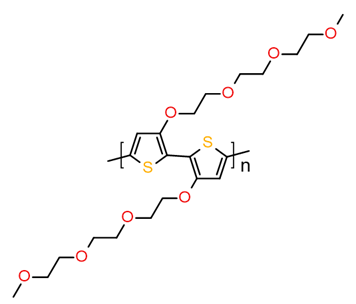
Electrochromic material
OMIEC, organic mixed ionic-electronic conductors for energy storage, electrochromic displays, bioelectronics, sensors, electrocatalysis, neuromorphic devices, thermoelectrics, and actuators
Mixed ionic-electronic conductors, also known as mixed conductors, are an increasingly important category of materials with applications in energy storage, electrochromic displays, bioelectronics, sensors, electrocatalysis, neuromorphic devices, thermoelectrics, and actuators.
Mixed conductors exhibit both ion and electron/hole conductivity, and ionic-electronic coupling (i.e., capacitance), allowing them to effectively transduce ionic signals to electronic ones, and vice versa.
In recent years, new mixed conductors have been developed beyond the traditional metals oxides and phosphates to include (semi)conducting polymers, radical polymers, perovskites, and hybrid organic-inorganic materials, enabling improved performance and new functionalities.
Structured below are examples of polymeric mixed conductors from 1-Material Inc.
1M Supports Material Research Society (MRS) constantly
1M Supports Material Research Society (MRS) constantly with reproducible Organic Nano Electronic (ONE=1) materials.
n-PBFDO, PBFDO, n-PBDF, n-type polymer, counter partner PEDOT, for OECT, capacitors, transparent electrode
Would the emerging poly(benzodifurandione)[PBDF, PBFDO] reported having an unprecedented high electrical conductivity upon reduction (“n-doping”) with protons, high optical transparency and low work-function, be outmatching the predominant counter-partner PEDOT:PSS? Please check links below to find more.
2TDPP-OD-TEG
2TDPP-OD-TEG is available for your research needs. For more information, please review the typical COA as exampled below:
PE2-OE3 PE2-OE4 Electrochromic Energy Storage OECT OMIEC and BioEL
Organic Mixed Ion-Electron Conductor (OMIEC):
PE2-OE polymers: Incorporation of the unfunctionalized biEDOT unit increases backbone planarity and overall electroactive polymer content, ultimately delivers low operational voltages, high transconductance, and promising pulsing stability; thereby deeming PE2-OE-based devices of high interest for the detection of biological events and amplifying signals for electrophysiological recordings.
ProDOT-4gDPP, PECD, OECT, OTE, BioEL
New ion-electron conducting polymers for ECD, OECT, OTE and BioEL applications.
OMIEC – Understanding Mixed Ionic-Electronic Conductors
1M is proud of support symposium #OMIEC – Understanding Mixed Ionic-Electronic Conductors within MATSUS Fall 24 conference.





